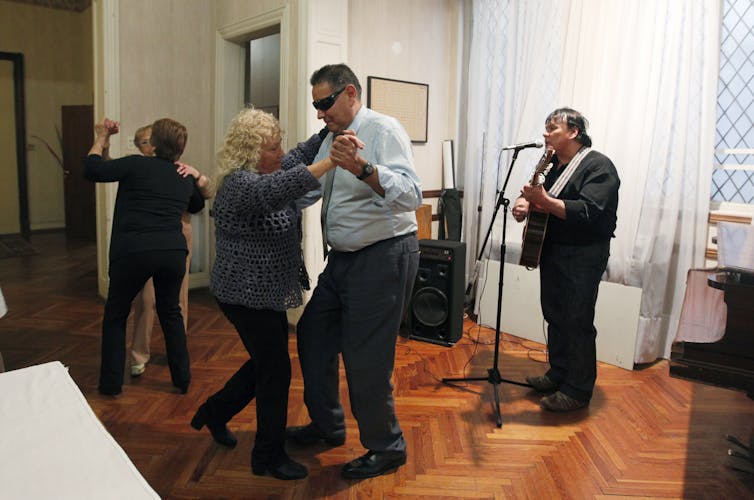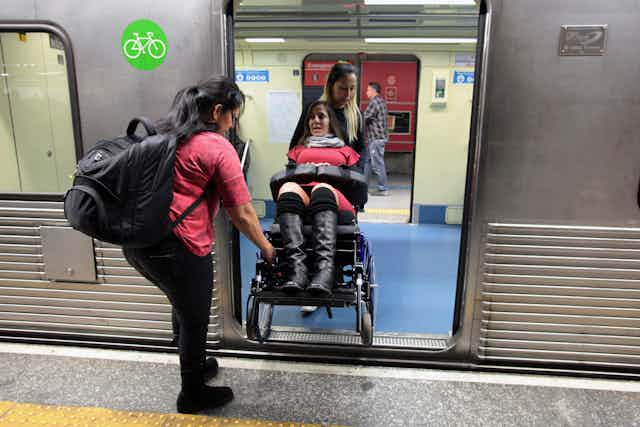In Argentina, there is no formal or legal barrier to women becoming judges. But according to a 2013 report, 56% of Inferior Judges, 67% of Appeal Judges and 78% of State Justices in Argentinean courts are men.
Why should this be the case? The answer is, of course, structural inequality.
It’s also the reason why today, across the world, people with disabilities lag behind in employment and health indicators across the world. So severe is the issue worldwide that in 2014 the United Nations created a Special Rapporteur position to examine the problem, which affects many of the one billion people – about 15% of the world’s population – who have some form of disability.
In Latin America, though statistics are not fully reliable, we know that many children with disabilities are not being educated: only 20% to 30% of children with disabilities attend school. According to the International Labour Organisation, 70% of people with disabilities of the region are unemployed.
In the US, people with disabilities are segregated and over-represented in civil and criminal institutions. According to the American Civil Liberties Union, 70% of US public school students who are physically restrained or secluded have disabilities, 60% of people in local jails have some form of mental disability and 48% of people with disabilities have an income of $15,000 or less.
The United Nations’ Special Rapporteur of the Human Rights Council has pointed out that people with disabilities are also more likely to experience poverty and social exclusion and less likely to be employed, receive an education, or gain access to public services; they are more likely to be the victims of violence and contract HIV/AIDS.
Principle of non-discrimination
As I have written in my latest book, understanding how both women and people with disabilities – not to mention people of colour, immigrants and other minority groups – are invisibly constrained requires understanding the difference between legal equality and real equality.
In liberal democracies, citizens have the right to equal treatment under the law, which means that governments should not differentiate among people without good reason to do so. This is known as the principle of non-discrimination.
But what if a government wants to reduce car accidents? In that case, it is allowed to provide driver’s licenses to some people and not to others.
Passing a driving test would seem to be a reasonable justification for determining who can and cannot drive a car. Being male or white, on the other hand, would not be legitimate, since sex and race have no connection with good driving.
In other words, public authorities may distinguish between groups of people – but only with a specific policy goal in mind.

When just not discriminating won’t cut it
But sometimes a government may actually end up creating or perpetuating inequalities among groups by complying strictly to the principles of equality and non-discrimination.
Take, for example, the original case of Argentina’s judiciary gender gap. No law says women cannot become lawyers, or be appointed as judges, and yet the facts strongly suggest that something is stopping them.
That’s because true equality requires a government to actually dismantle structures that perpetuate group disadvantage, either by providing preferential treatment or special protection to those on the wrong side of invisible barriers.
Social movements of the second half of the 20th century pushed governments across the world to implement such policies, from affirmative action in university admissions for racial minorities in the United States and quotas for women in the Argentinean congress to Uruguay earmarking public-sector jobs for Afro-Uruguayans.
None of these preferential treatment policies are a magic solution for ending group discrimination and segregation, but without them the number of African Americans in US and Brazilian universities, or women in the Argentinean Congress, would be far less than they are today.
Still, people with disabilities remain largely excluded from such efforts, despite the many obstacles that persist in their everyday lives. These barriers can be both invisible, in the form of attitudes or assumptions held by others, and physical, as when steps or staircases literally prevent people with disabilities from accessing public spaces, offices and transport.

True equality, that ‘most difficult problem’
The urgent necessity of such policies for historically marginalised groups was made most eloquently by US Supreme Court Justice William Brennan in the 1982 in Plyler v Doe, which struck down a statute that allowed schools to deny admission to undocumented immigrant children.
In the judgement, Justice Brennan wrote of structural inequality that:
Sheer incapability or lax enforcement of the laws barring entry into this country, coupled with the failure to establish an effective bar to the employment of undocumented aliens, has resulted in the creation of a substantial ‘shadow population’ of illegal migrants – numbering in the millions – within our borders … This situation raises the spectre of a permanent caste of undocumented resident aliens, encouraged by some to remain here as a source of cheap labour, but nevertheless denied the benefits that our society makes available to citizens and lawful residents.
Brennan concluded with a passionate defence of the “equality as non-subordination” principle that today underlies affirmative action, quotas in congress and other measures to prevent the invisible discrimination faced by people in historically marginalised groups.
There are some examples of specific measures intended to help level the playing field for people with disabilities. Austria mandates that 4% of private- and public-sector jobs must be set aside for people with long-term disabilities, for example. Advocacy groups also recommend increasing the accessibility of public information and educational materials and mandating inclusive workplaces.
But such initiatives remain rare. What would Justice Brennan say?

Governments have a duty – not to mention an obligation under international human rights law – to respect and protect all citizens, including those with disabilities. That means undertaking all possible measures to dismantle barriers to equality within their borders.
It’s not as simple as just adding a wheelchair ramps. People with disabilities have the right to true equality, not just equality under the law.

